Ube pandesal is your favourite Filipino bread roll but ube flavoured! Make it plain, with cheese, with ube halaya, or with cheese and ube halaya. Have it for breakfast, dip it in coffee Filipino-style, enjoy.
(Looking for something sweeter? Try these ube bread rolls. They’re filled with ube jam and baked with a mouthwatering coconut topping. Or make something truly special with a batch of ube ensaymada!)
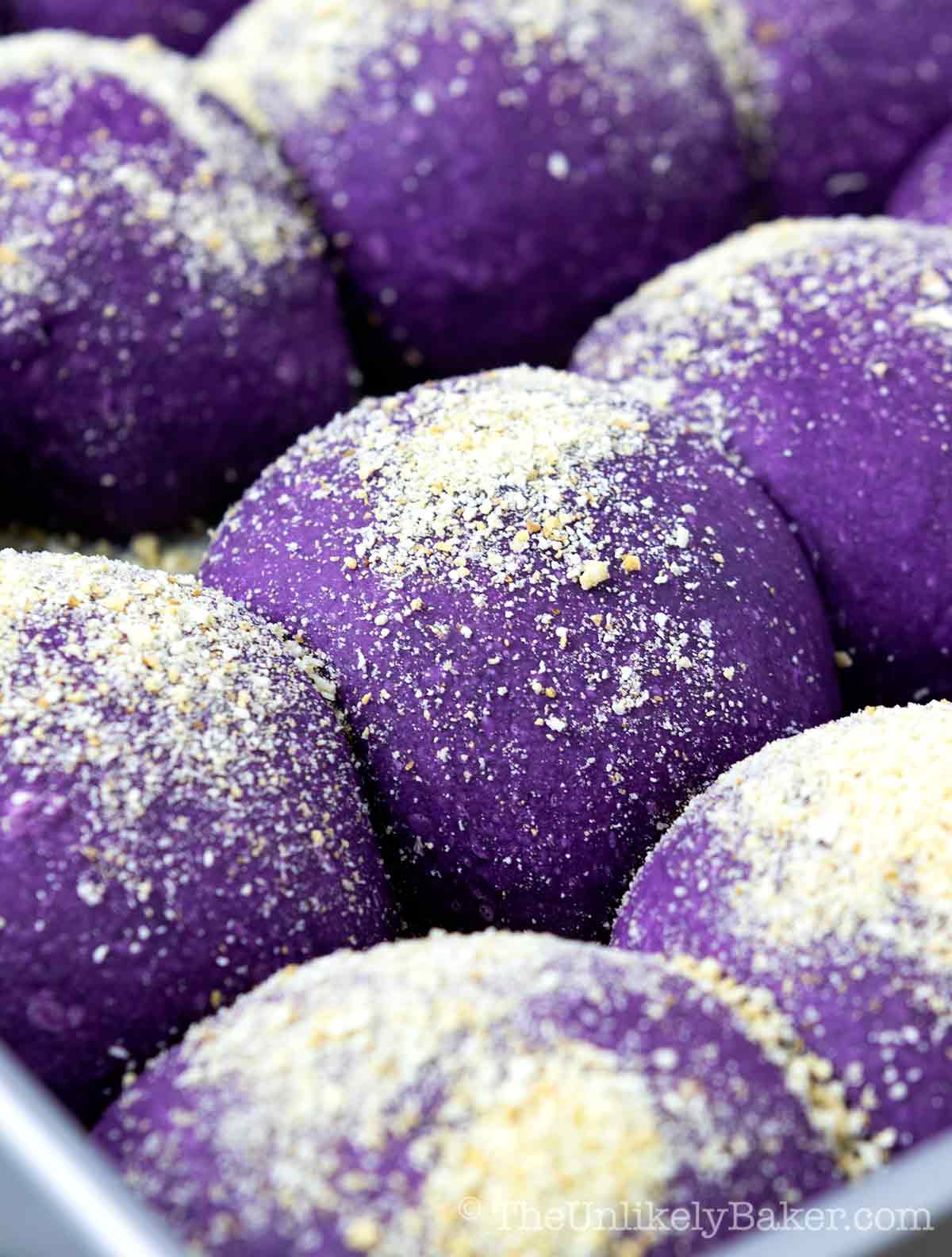
Ube pandesal (also called ube cheese pandesal because it’s often made with a cheese filling) is a relatively new pandesal creation. At least for me because it was certainly not a thing when I lived in Manila.
It’s become so popular in recent years and I’ve seen a gazillion social media posts about them, enough to make me want to develop my own recipe.
Why you’ll love making this recipe
And I couldn’t be happier about the recipe I’m sharing today.
I based it on my soft pandesal recipe so these have the same fluffy and tender texture but with a hint of ube flavour.
You’ll love making it because:
- It’s easy and straightforward. Like my traditional pandesal recipe, this is easy and simple to follow. I break it down into small, manageable parts.
- The ube flavour is not overpowering. The ube flavour here is very subtle so it’s still the pandesal you love and that you can enjoy with coffee and eggs at breakfast or warm milk at merienda.
- You can customize the filling, or not put any at all. If you want a stronger ube flavour, you can fill the bread with ube halaya or ube jam. Or you can make ube cheese. You can even mix both. You can also just make plain ube pandesal, no cheese, and not have any filling at all. Just spread some ube butter and call it a day!
- Freezes well. This Filipino bread freezes very well. So you can make a big batch today, freeze them, and enjoy them tomorrow like they’re freshly baked.
How to make ube pandesal
Ingredients
To make this recipe, you’ll need:
- Warm water — around 110F. If you don’t have a thermometer, you can tell if it’s warm enough by dipping a finger in; it should be warmer than room temperature but not hot.
- Active dry yeast — see baking tips where I explain why I use this kind of yeast rather than instant yeast.
- Ube extract — I use ube extract to add ube flavour in this recipe. I’ve found that adding ube halaya or even just plain mashed purple yam to the dough changed the texture of the bread too much and I prefer the perfectly soft and fluffy bread I get with ube extract alone. I simply fill the pandesal with ube halaya if I want a stronger bite of ube in there.
- Oil — I most often use canola oil. Vegetable oil also works.
- All purpose flour — I don’t use bread flour when making bread. More on this below.
- Bread crumbs — this is one of the things that make pandesal unique. I use plain, ready-made breadcrumbs.
- Sugar and salt
Baking tools
I knead the bread dough by hand but you can definitely use the dough hook of your stand mixer.
I do use a French rolling pin, 9×13 inch baking pans, mixing bowls, measuring cups and spoons, and a bench scraper.
The top 2 items I can’t recommend enough when making homemade bread are:
- Silicone pastry mat — this makes cleanup so easy and it’s easy to wash and store as well.
- Kitchen scale — for accurate measurements and consistent results.
Easy recipe (with step-by-step photos)
Proof yeast. Mix sugar and yeast in a cup or small bowl and wait until bubbly before using. This usually takes 10 minutes. If you’re not seeing any changes after that time, you’ll need to discard and start again.
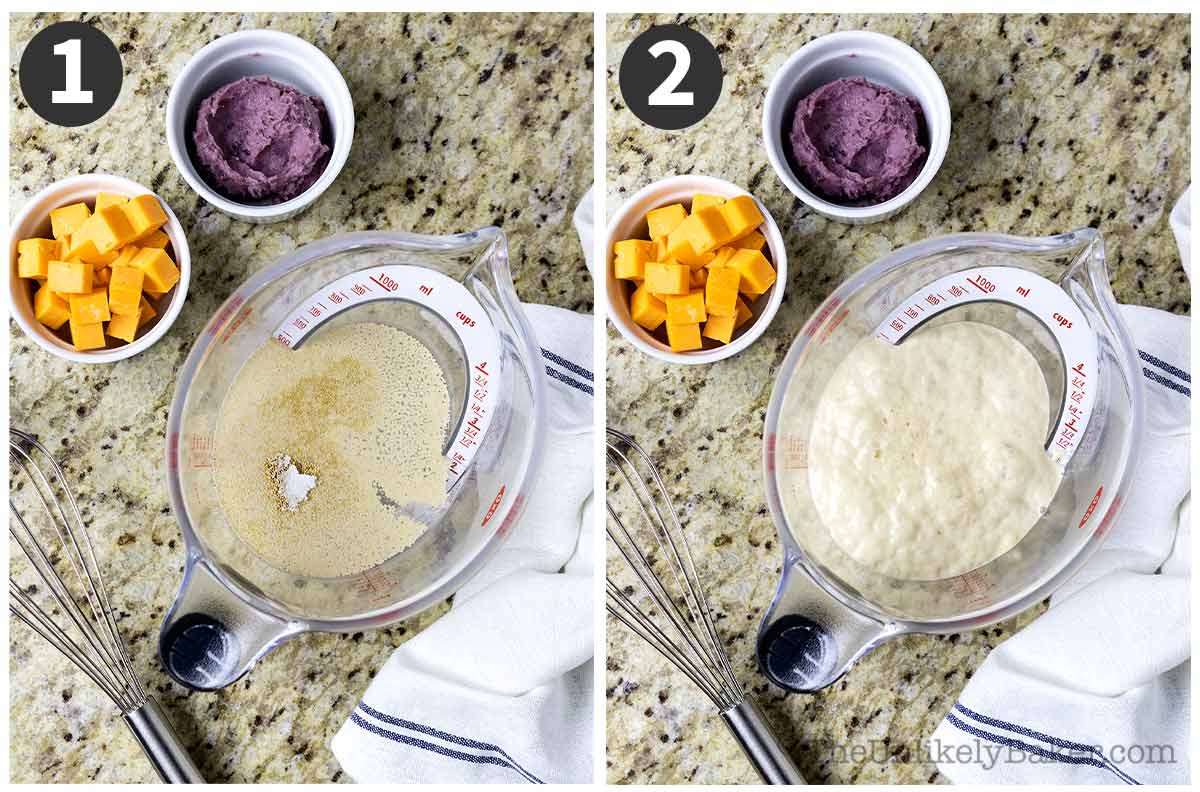
Prepare dough. Combine sugar, salt, oil, ube extract, yeast mixture and flour in a large bowl. Add the flour about ½ cup at a time until the dough starts sticking together in a ball. You can then transfer it to a floured surface and knead until smooth and elastic (see baking tips).
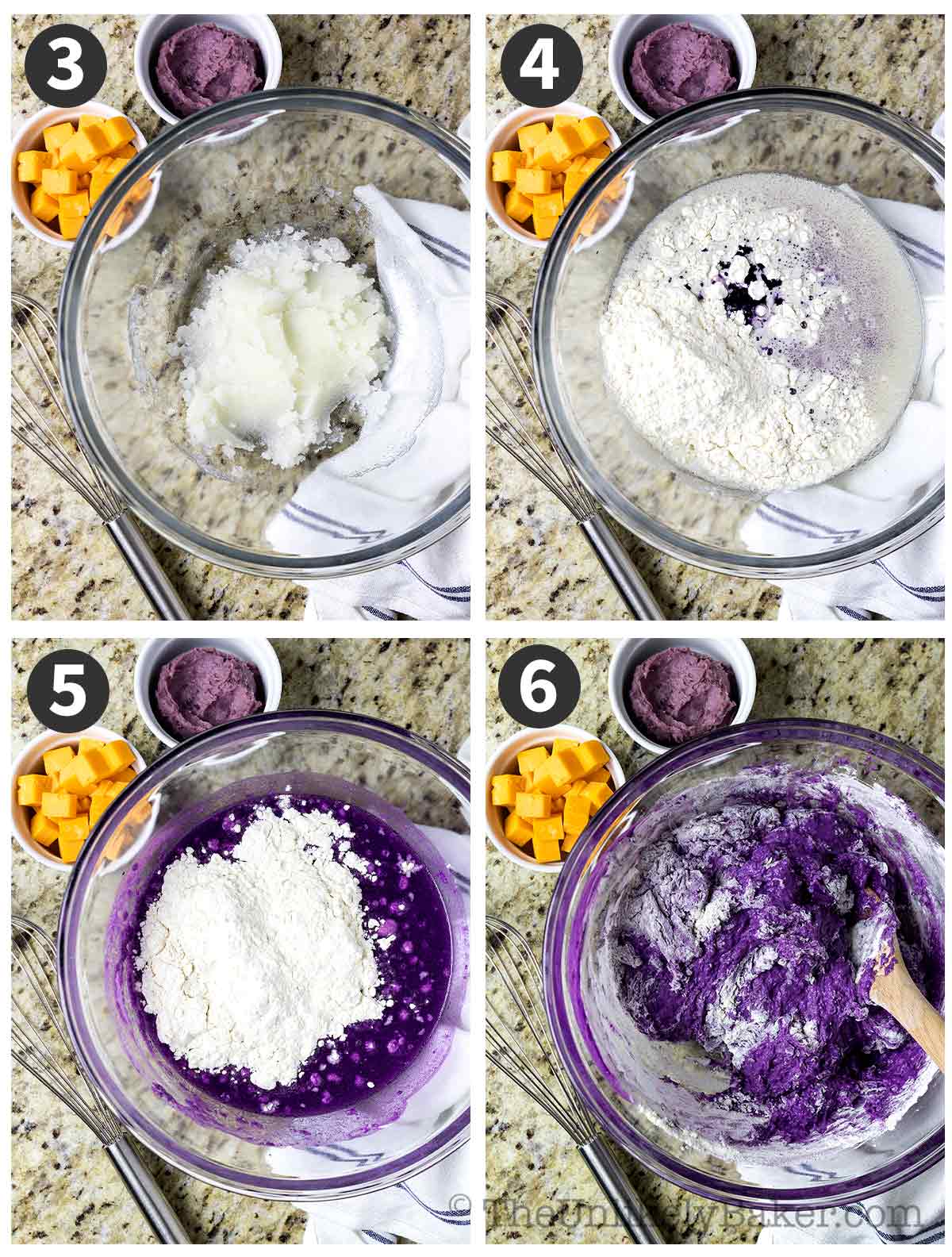
First rise. Transfer dough into an oiled bowl and cover with a damp cloth or plastic wrap. Place in a dry, warm place and allow to rise until double in size (see tips). This usually takes 2 hours for me. It may take more or less time for you; just peek at the dough and decide if it’s ready.
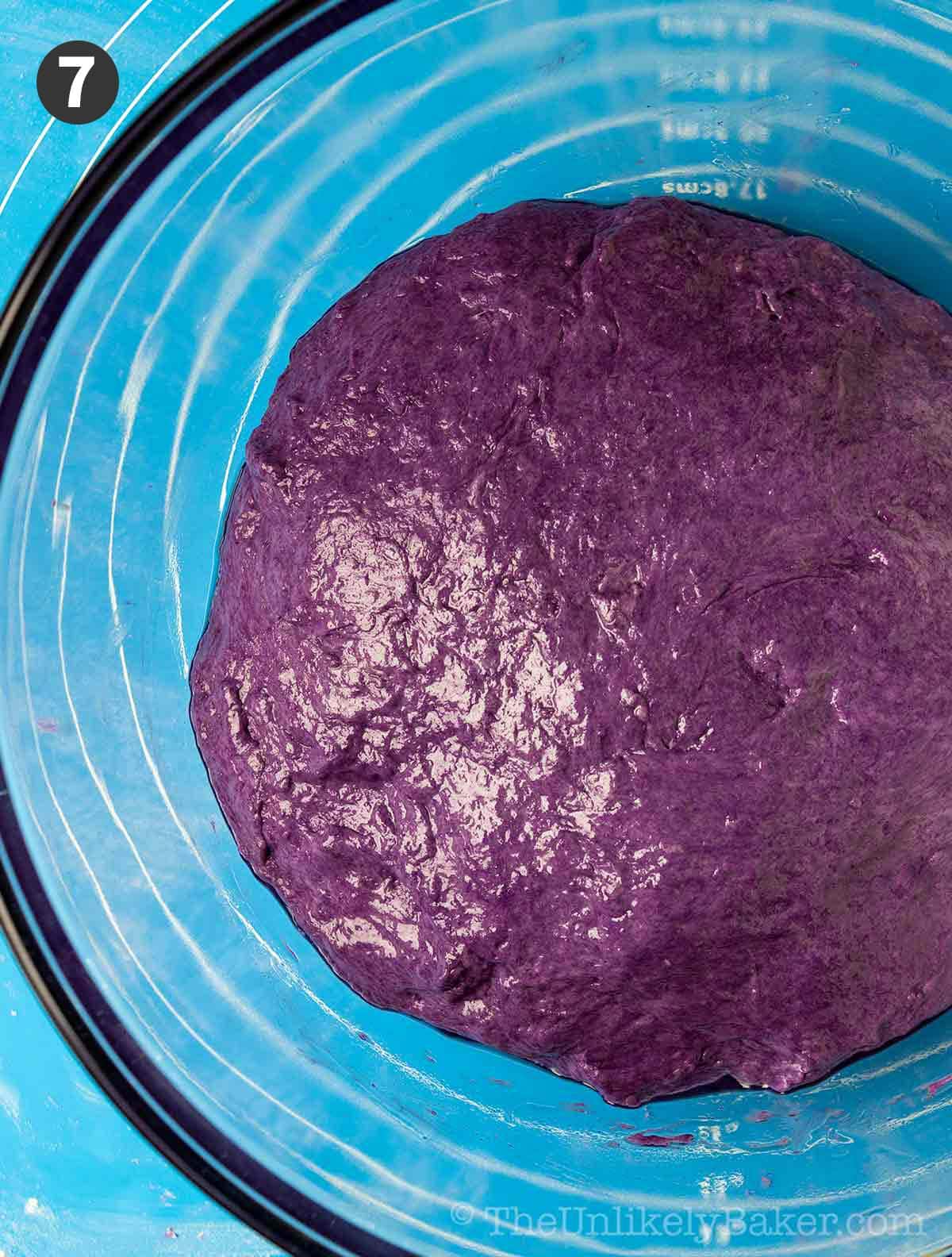
Shape and fill. When ready, turn the dough into a lightly floured surface, knead slightly and divide into 32 pieces. Shape into an oval and place on a 9×13 baking pan (you will need 2 pans). If filling, flatten slightly, place a piece of cheese, a dollop of ube jam, or both, in the middle before shaping. Cover with a damp cloth or plastic wrap and allow to rise a second time (usually takes an hour).
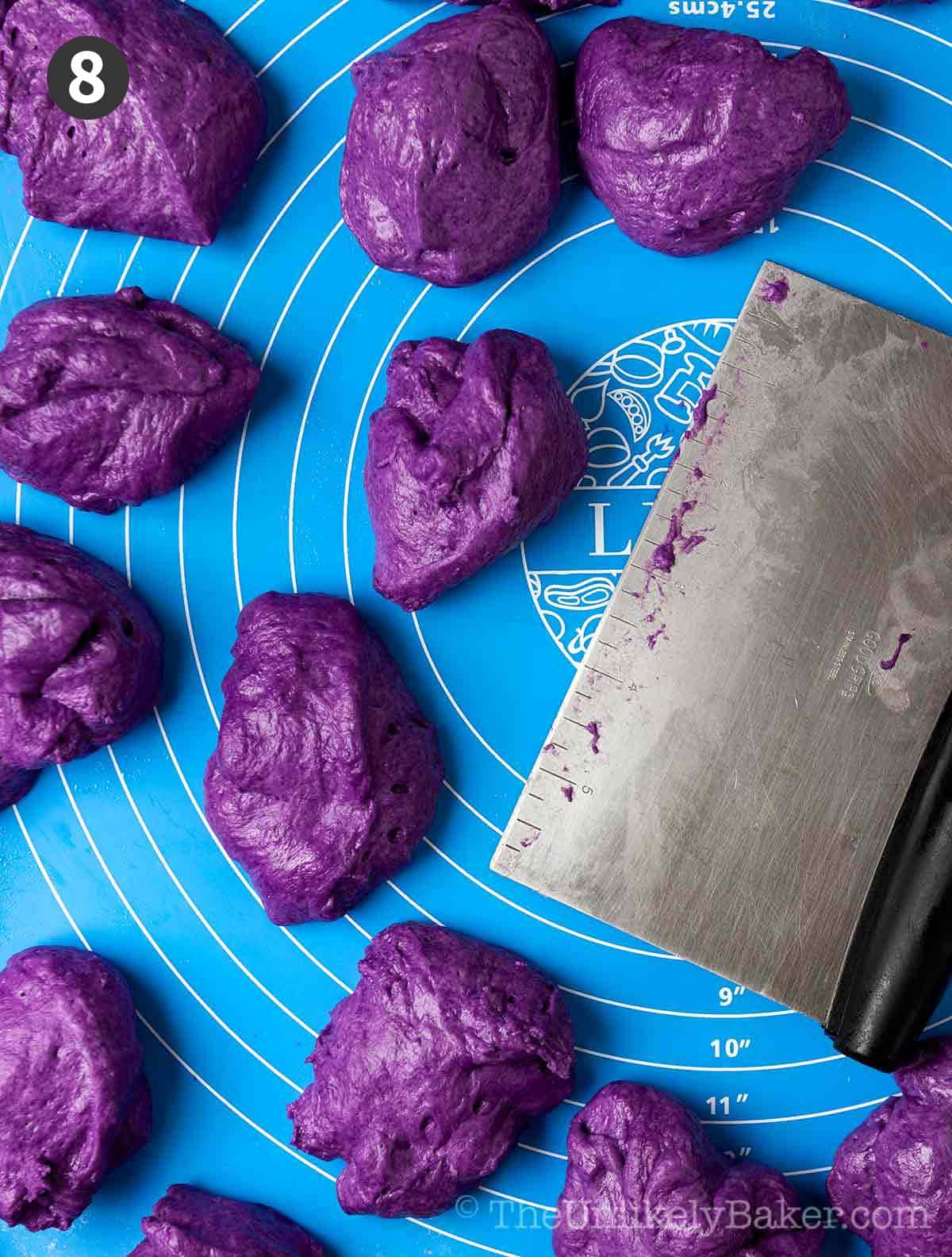
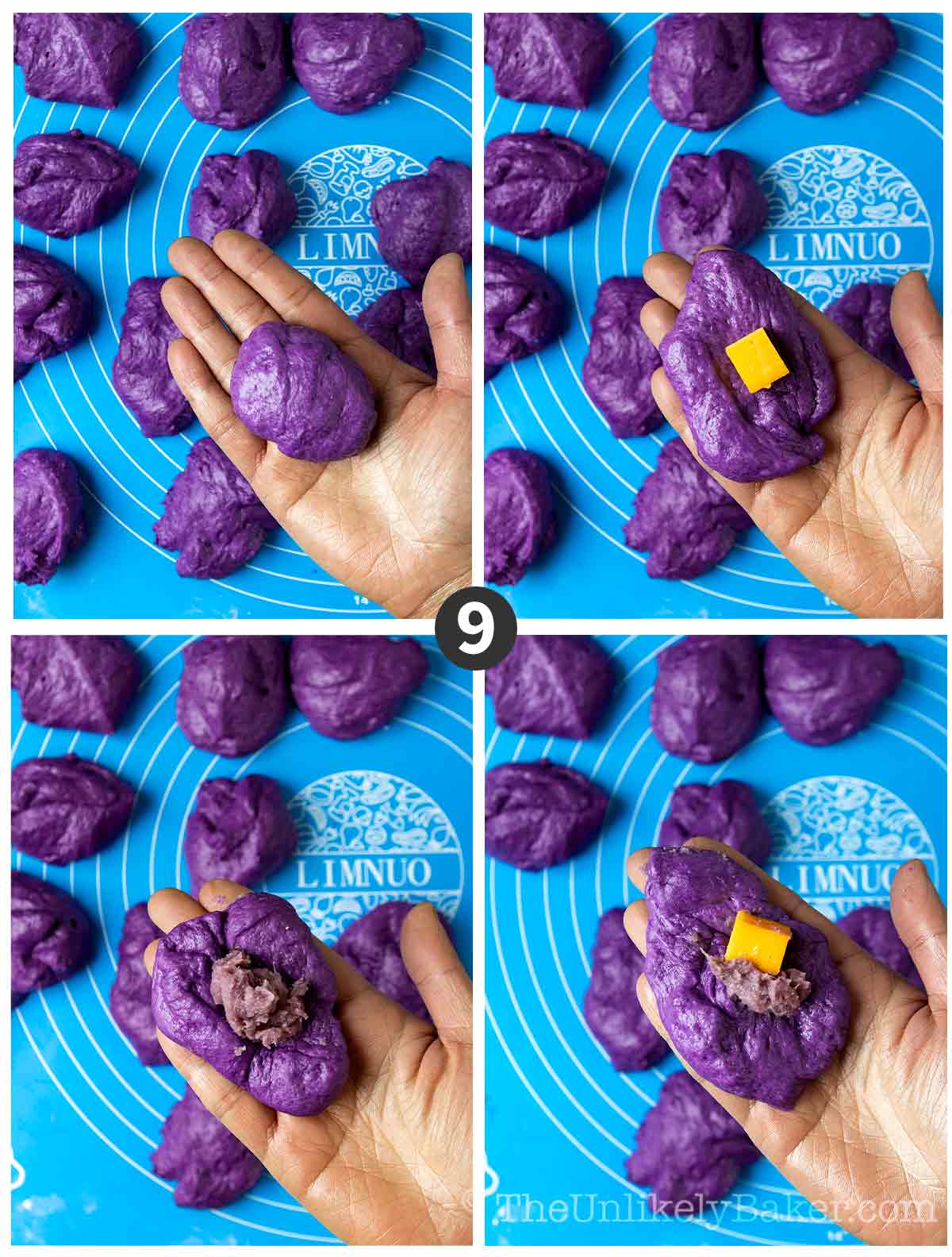
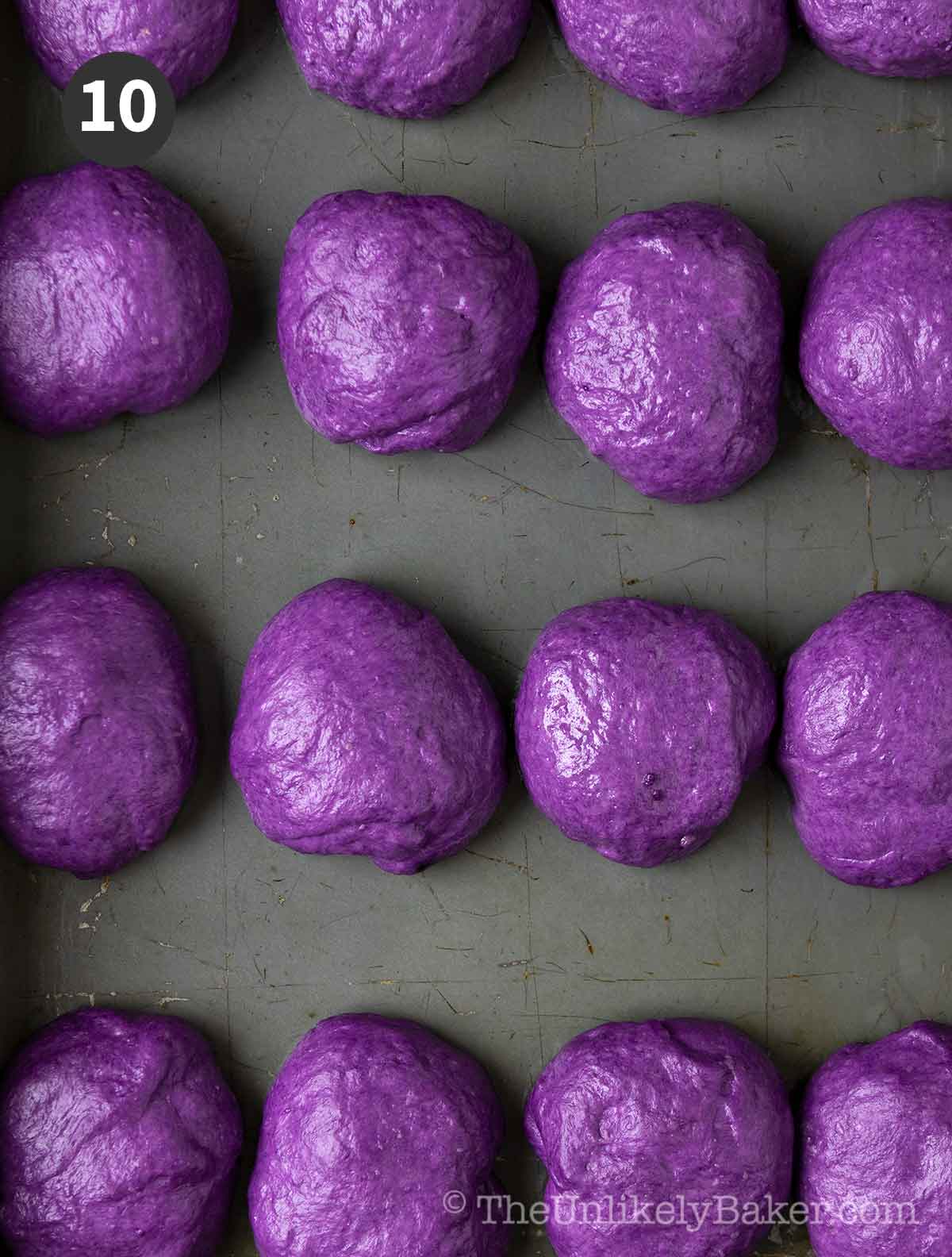
Bake. Preheat oven to 375F. Sprinkle bread crumbs on the top of the pandesal and bake for 15-20 minutes or until the bread springs back when gently pressed. Since you’re using 2 baking pans, it’s good practice to rotate the pans halfway through baking.
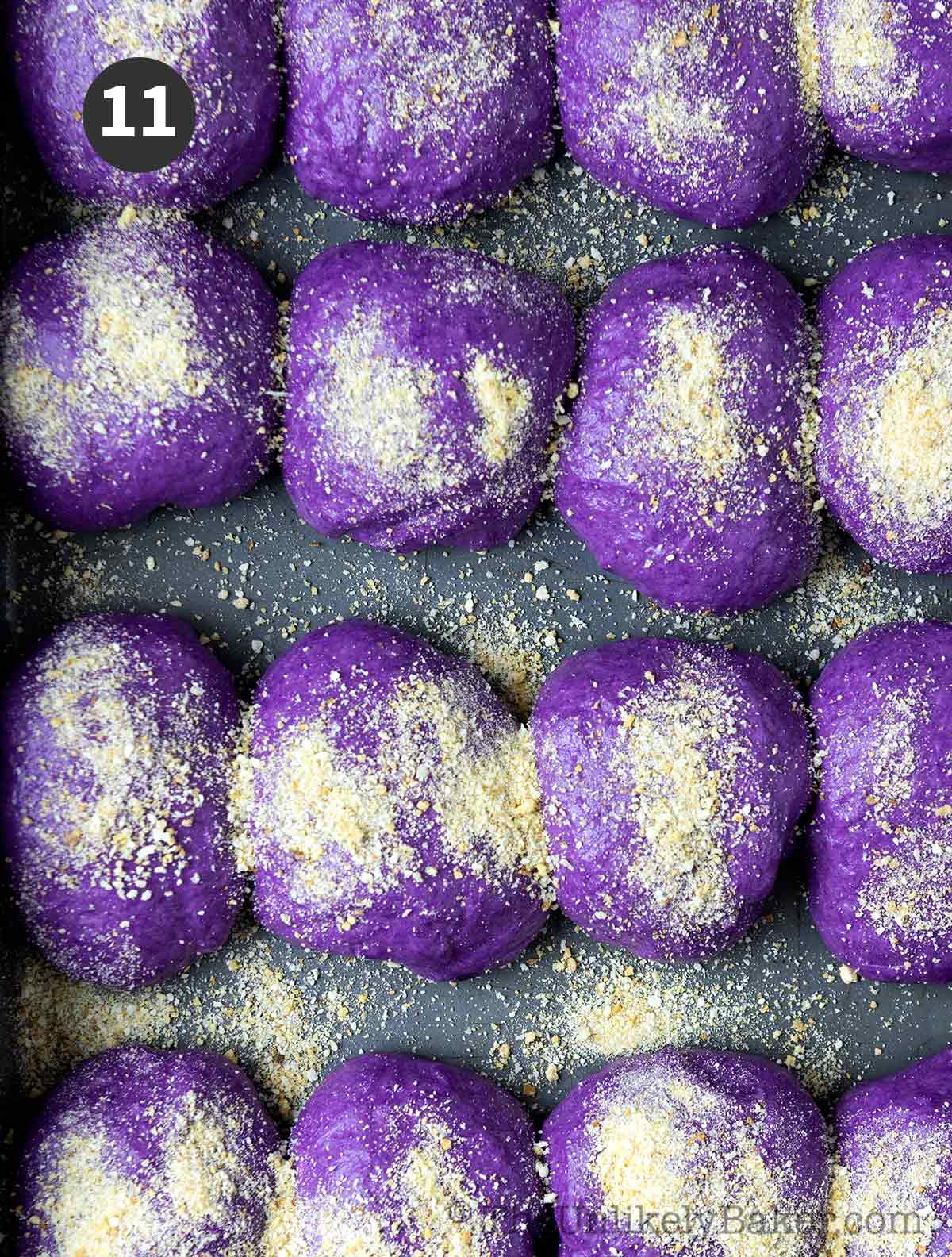
Expert baking tips
Easy, right? Read through these baking tips for a perfect batch of ube pandesal every time.
How to make ube pandesal soft and fluffy
- Proof yeast properly. The reason I prefer using active dry yeast vs. instant yeast is I can always ensure it’s still active before adding it to my dough, via proofing. If the yeast stays flat and doesn’t bubble after 10 minutes, it’s old and you need a fresh batch. See more tips below.
- Make sure that your dough is not too dry. This pandesal dough is on the stickier side but don’t be tempted to add too much flour when kneading or you will end up with dense bread. If you’re having a difficult time, instead of adding more flour to your surface, try kneading with lightly oiled or damp hands instead.
- Knead the dough enough. Kneading improves the structure of the dough, making it stretchy and pliable, and forming a structure that will trap air for a proper rise. Under-worked dough won’t have that and will result to dry, dense bread.
- Don’t knead the dough too much. I like kneading the dough by hand because it rarely results to over kneading. Using a stand mixer is more convenient but it’s more likely to over work the dough so be sure to watch it carefully. Once you get that perfectly elastic but still slightly sticky dough, stop.
Tips when proofing yeast
Remember that yeast is a living thing and proofing is simply ensuring that your yeast is alive and active.
In this recipe, we use active dry yeast, which needs to be proofed. Note that rapid-rise yeast, instant yeast, or bread machine yeast don’t need to be, else they will lose their fast-rising ability.
Step 1: Mix yeast and warm water.
The temperature of the water is important. It should feel warm but not hot.
If you measure the temperature with a thermometer, it should be about 110F. Hotter than that and you’ll end up killing the yeast.
Step 2: Add sugar and stir.
Yeast loves sugar and will gobble it up.
If you watch the bowl or cup, you will actually see movement and this is the point when you will start to see bubbles and foam from the carbon dioxide that is forming.
Proofing usually takes me about 10 minutes. If your mixture has no bubbles after this time, your yeast is old or stale. You’ll need to start with fresh yeast.
Unfortunately, there’s no way to revive old yeast.
Tips for dealing with sticky dough
If your dough is sticky in the bowl as you’re stirring it, add flour a little at a time until it sticks together in a ball. Not too much though, or you’ll end up with very dense bread.
If it’s sticky while you’re kneading it, avoid the temptation to add even more flour. Instead, try kneading with slightly oiled or damp hands.
How to know if dough is kneaded enough
The most common way of testing if your dough has been kneaded enough is doing the “windowpane test”.
All this means is you pull off a small piece of dough and stretch it thin; if the gluten is well-developed, the dough will stretch without breaking. If it quickly breaks you need to keep kneading.
Tips for making the dough rise
A lot of recipes say to allow the dough to rise until “double in size”.
Depending on the recipe, this can range from 30 minutes to 2 hours. Just check at the halfway mark so you can get an indication of how much longer you have to go.
For me, what’s important is finding the proper place to leave my dough.
It’s cold here most of the year so leaving my bowl on our not-so-warm counter is not ideal.
So what I do is turn my oven on to its lowest setting for a few minutes, then turn it off so that it’ll be about 90F when I’m ready to put my dough in to rise.
Just remember to remove the dough from the oven when you’re ready to preheat for baking.
And do you really need a damp cloth to cover your dough while rising? I do it most of the time but it’s not necessary. Sometimes I use plastic wrap. And other bakers I know use pot lids.
The key is covering the bowl with something because doing so helps the dough retain moisture and prevents it from drying out.
How to have evenly sized pandesal
I get evenly sized pandesal by weighing the dough and dividing the weight by the expected yield, in this case, 32. I then ensure each piece of dough is that exact weight (usually in grams).
To do this, you’ll need to invest in a kitchen scale. And it really is one of the best gadgets we’ve added to our kitchen and has improved my baking tenfold.
While you can get away with volume measurements with a lot of recipes, bread making is more exact so it’s always better to weigh your ingredients.
How to make sure the filling doesn’t ooze out
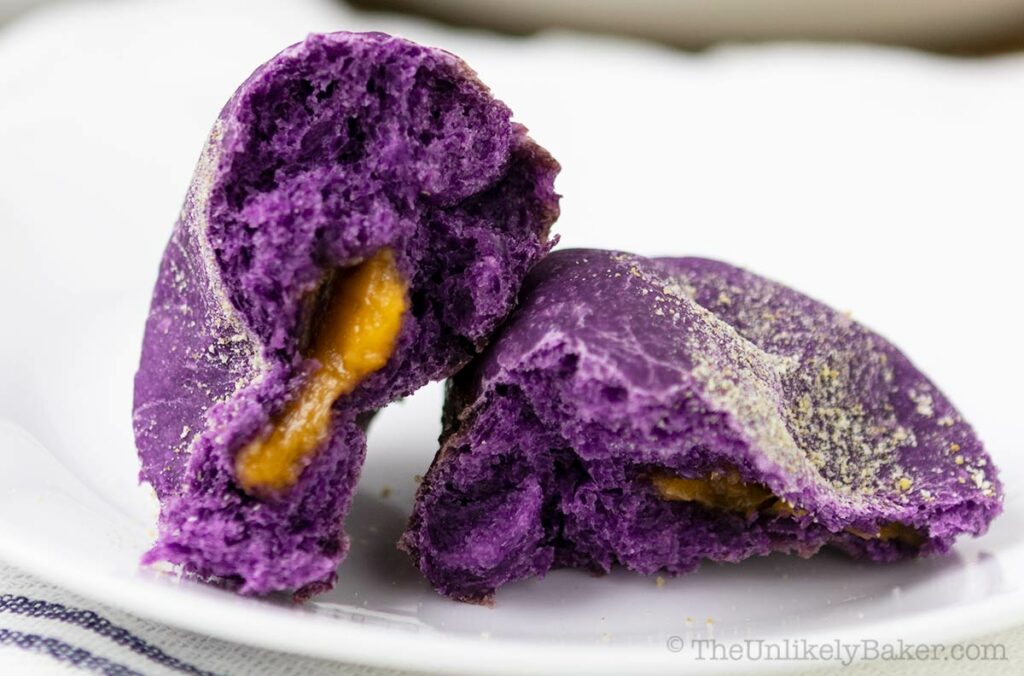
When making ube cheese pandesal or ube-filled pandesal, you’ll want to properly seal in the filling so it doesn’t ooze out during baking.
What I do is fold the dough over the filling completely, pinch to seal (much like a dumpling), then shape.
Best cheese to use
I would love to use Eden Quick Melt Cheese in my recipe but they’re very expensive where I live. So I use a block of sharp cheddar cheese that I slice into cubes instead.
You can also try using cream cheese for a different flavour profile.
What’s important is to use a cheese that you like eating on its own and cheese that would melt nicely while baking.
Frequently asked questions
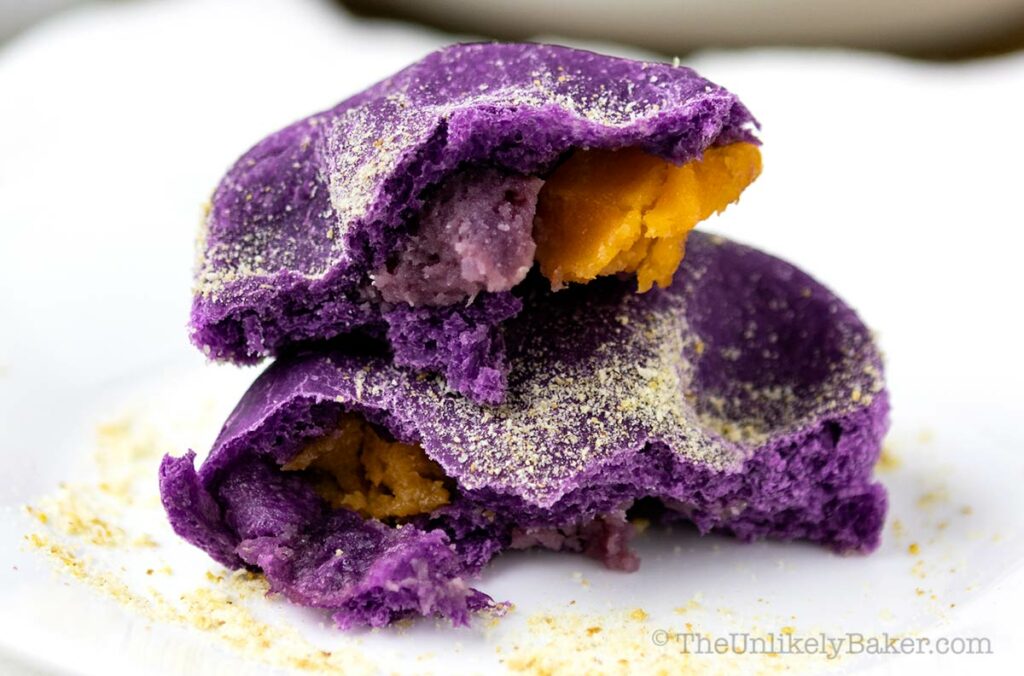
The most common reasons for hard and dense pandesal include:
– Too much flour added to the dough, drying it up
– Yeast used was stale
– Dough was kneaded too much, or not enough
– Over-baking
See the notes above for tips on how to make pandesal soft.
I personally don’t use bread flour to bake bread. I always use all-purpose flour because that’s what I always have on hand. And I’ve had great success with it.
So if you don’t have bread flour, no worries. You can use all-purpose flour and make very tasty bread out of it.
I did read that the higher percentage of gluten in bread flour (somewhere between 11-14%) makes it ideal for bread because it makes the dough more elastic and easier to work, resulting to lighter textured breads.
So if you’re curious or if you have bread flour on hand, you can substitute bread flour for all-purpose flour easily. It’s a 1:1 substitution. You can read all about it and the different kinds of flour here.
You can absolutely make ube pandesal without breadcrumbs.
It’s the unique thing about this Filipino bread roll but if you’ve run out or simply don’t care for them, you can leave it out and still enjoy it.
As with classic pandesal, ube pandesal is best eaten fresh out of the oven.
Plain ones will last up to 2 days on your counter in an airtight container. If you plan to keep them for longer, freezing is a better option.
Ube pandesal filled with cheese or ube jam will need to be frozen if not consumed immediately.
Frozen pandesal can last at least a month.
Make sure the bread is completely cool then place them in a freezer-safe container or a large freezer bag and put in the freezer.
To reheat, simply pop into your toaster for a few minutes until heated through. No need to thaw.
I don’t recommend microwaving pandesal because that would make it tough and dense.
Other Filipino bread recipes
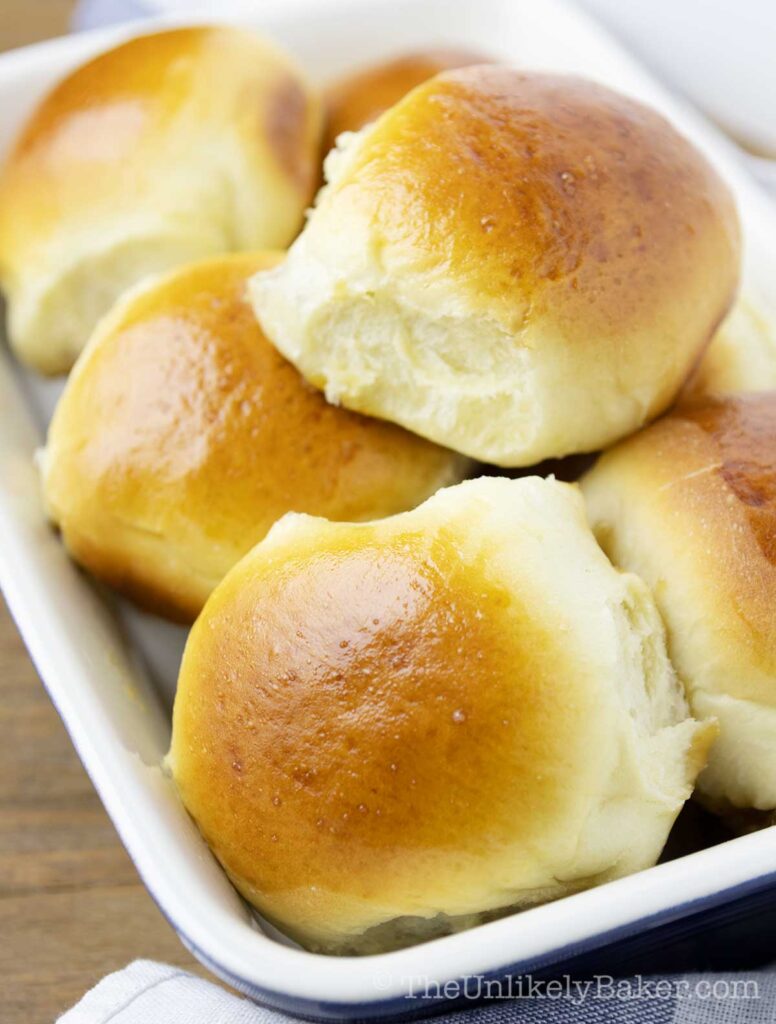
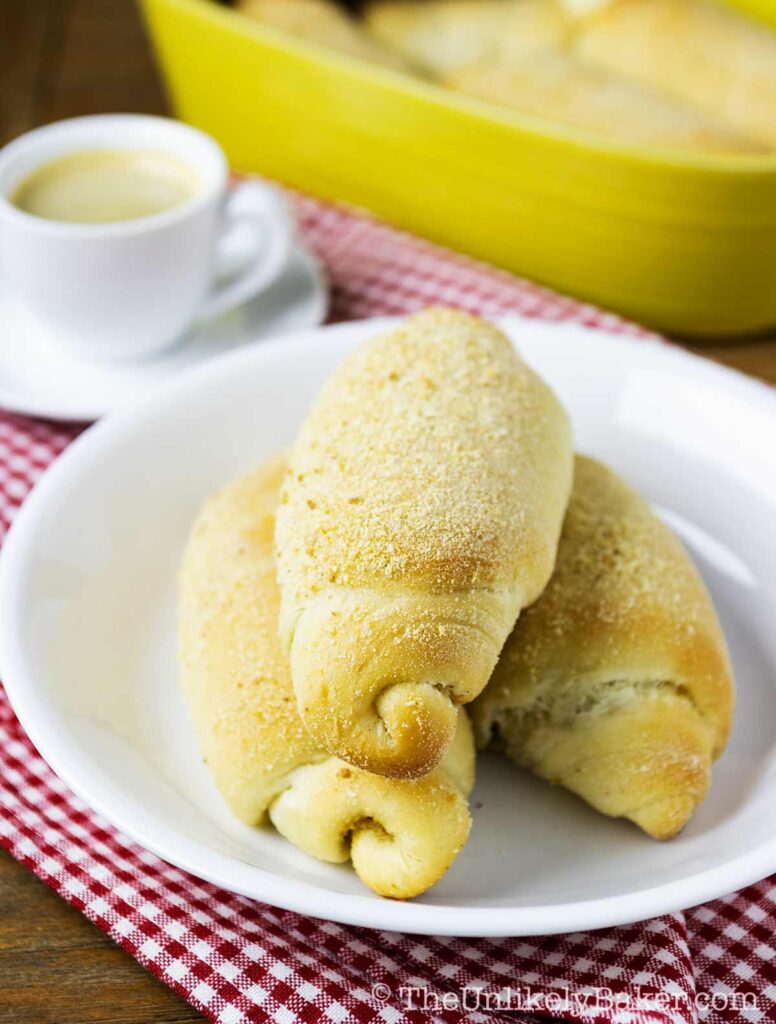
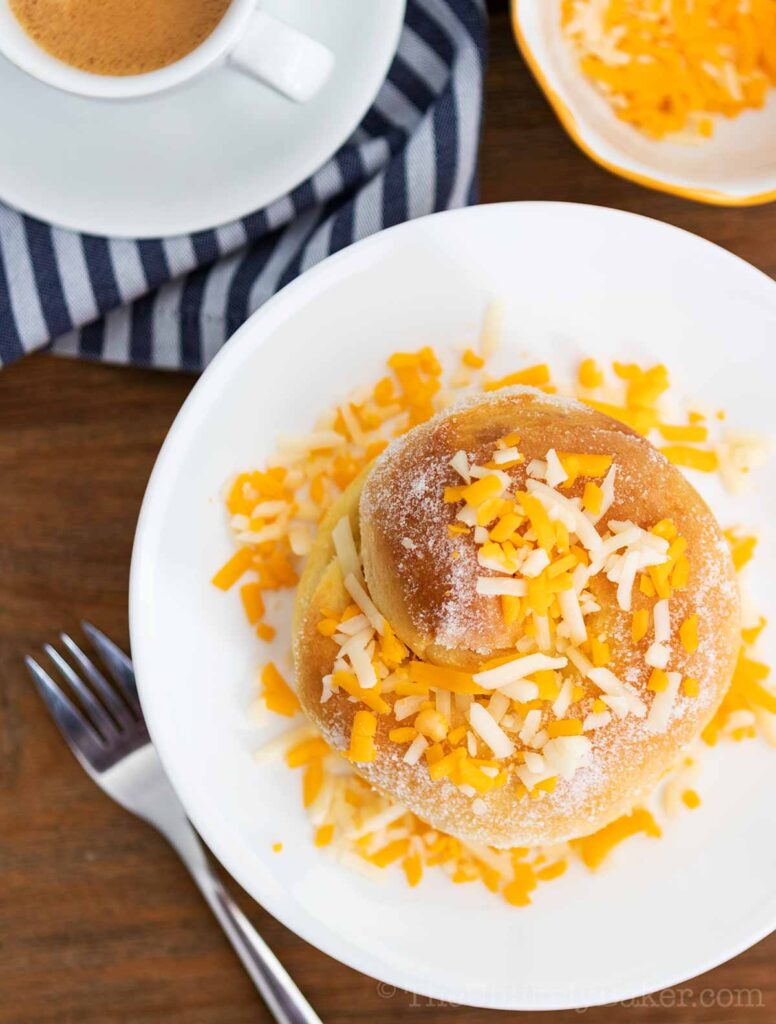
Love making homemade bread? Check out these other Filipino bread recipes you’re sure to enjoy:
Here’s a list of Filipino bread recipes and bakery favorites so you can have them all in one place.
Happy baking!
Did you make this recipe? I’d love to hear from you in the comments section below.
And let’s get social! Find me on Facebook, Pinterest, Instagram, Twitter and YouTube.
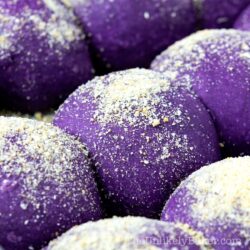
How to Make Ube Pandesal (Plain, Cheese, Ube Jam)
Ingredients
Yeast Mixture:
- 2 cups warm water around 110F
- 2 tsp active dry yeast
- 1 tsp granulated sugar
Dough:
- ⅔ cup granulated sugar
- ¼ cup canola oil plus more for the bowl
- 2 tbsp ube extract
- 2 tsp salt
- 6 cups all-purpose flour plus more for kneading, see notes
Optional Fillings:
- cheddar cheese cubed
- ube jam softened to room temperature
Topping:
- ¼ cup bread crumbs see notes
Instructions
Yeast Mixture:
- In a measuring cup or small bowl, stir warm water, active dry yeast and sugar until combined. Set aside and let stand until bubbly (about 10 minutes).
Dough:
- In a large bowl, stir sugar and oil until combined.
- Add salt, yeast mixture, ube extract and 1 cup flour. Stir until well blended.
- Proceed to add the rest of the flour ½ cup at a time, combining well after each addition.
- Once the dough starts pulling and sticking together in a ball, transfer to a lightly floured surface and knead until smooth and elastic (8-10 minutes).
- Oil another large bowl and transfer dough there. Turn to ensure all sides of the dough is coated.
- Cover the bowl with a damp cloth or plastic wrap and allow to rise in a dry, warm place (about 90F) until it doubles in size (about 2 hours).
- When ready, turn the dough into a lightly floured surface, knead slightly and divide into 32 pieces.
- Shape each piece into an oval – like an egg – and place onto a lightly greased 9×13 inch baking pan (you'll need 2 baking pans).
- Optional: if filling – flatten each piece of dough slightly, place a piece of cheese, a dollop of ube jam, or both, in the middle. Fold the dough over the filling completely, pinch to seal (like a dumpling), then shape.
- Cover baking pans and allow to rise a second time (about 1 hour).
Bake:
- Preheat oven to 375F.
- Sprinkle bread crumbs on top of the ube pandesal and bake for 15-20 minutes or until they spring back when gently pressed.
- Remove from oven. Best enjoyed freshly baked.
Video
Notes
- This dough is very sticky and you’ll need flour to make it easier to knead. Add flour a little a time, making sure not to add more than ⅓ cup in total.
- If the dough is still sticky, instead of adding more flour, knead with lightly oiled or damp hands instead.
- I use ready-made, plain bread crumbs.
- For best results, use a kitchen scale and weigh your ingredients.
- Since you’re using 2 baking pans, it’s good practice to rotate the pans halfway through baking.
- See post for more baking tips and FAQs, plus step-by-step photos.
Nutrition
Nutritional information are estimates only.

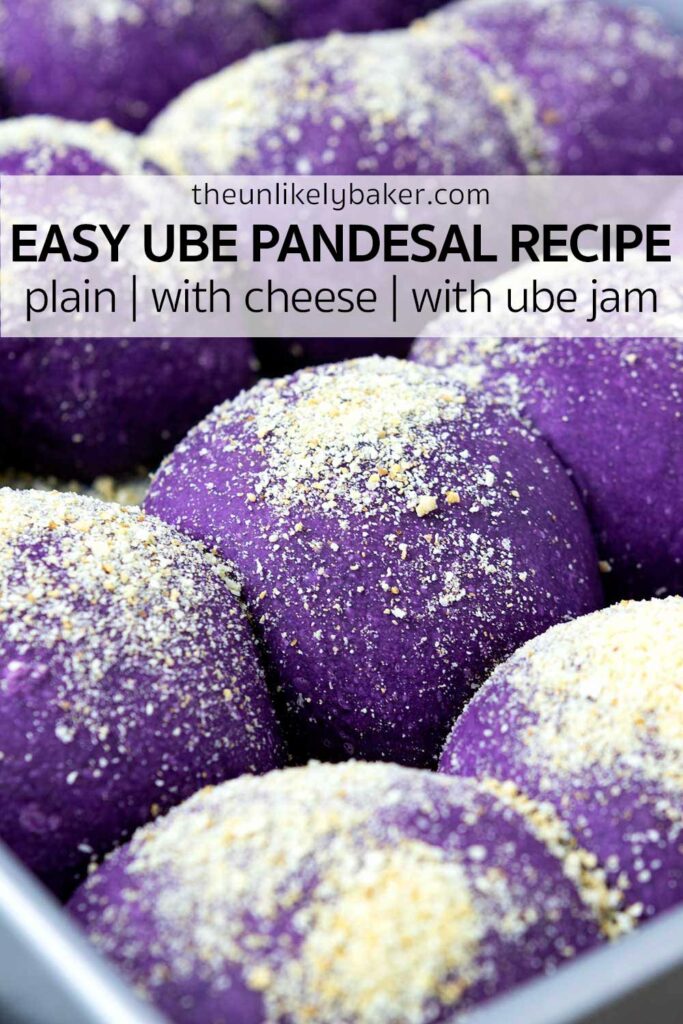
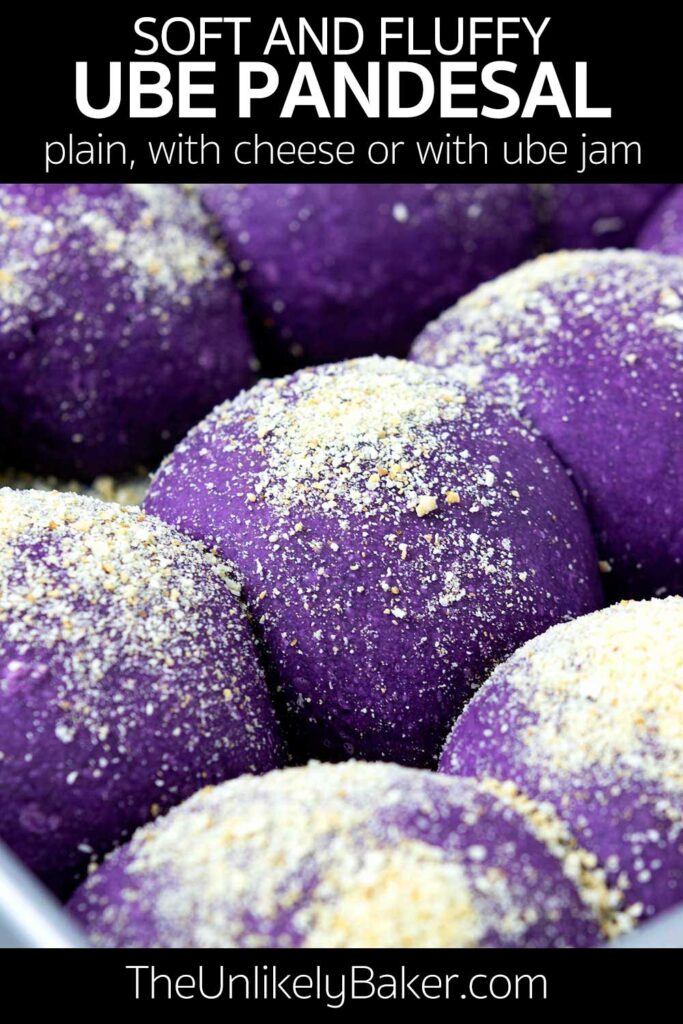
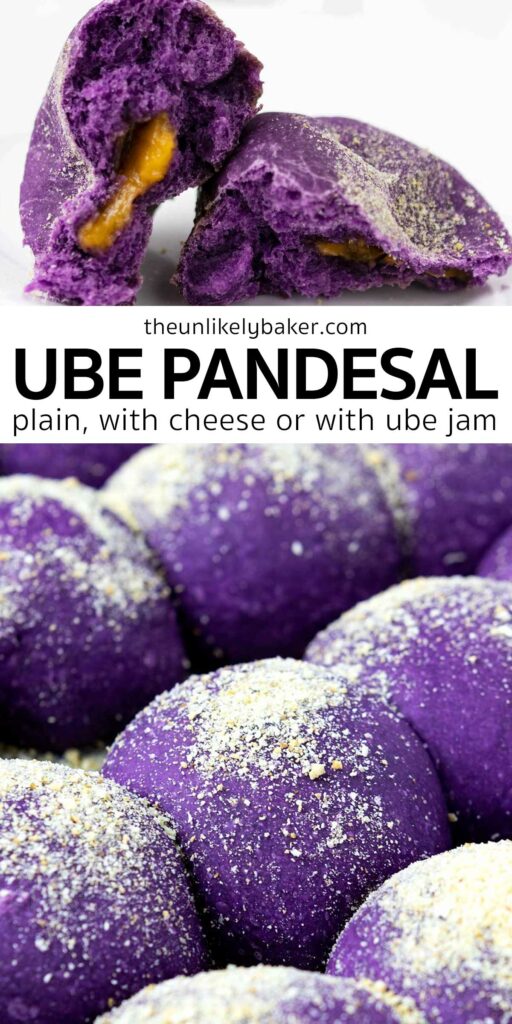
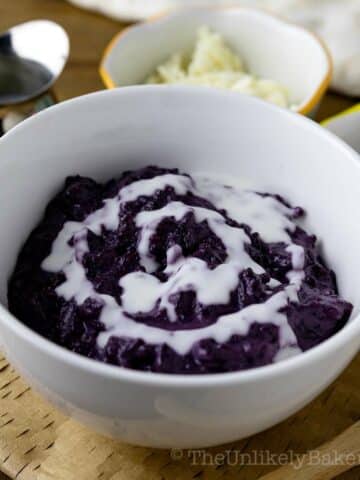
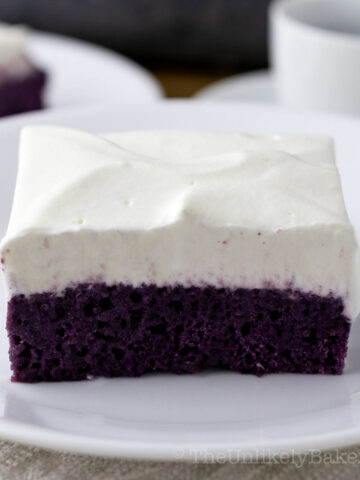
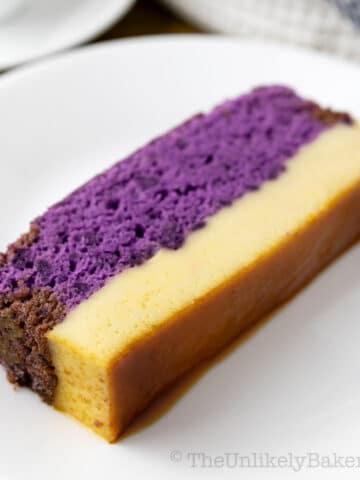
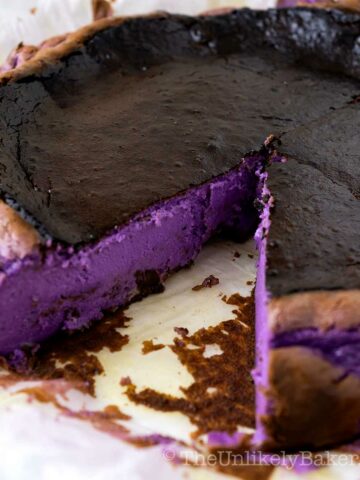
Ann
Sooo happy I found this recipe. I wanted the most simple way of baking ube pandesal. I was hesitant to do any kind of bread anymore as my first try was a disaster. I can’t be any happier with the result this time. Boosted my confidence in baking bread. The tips were really helpful. Can’t wait to try your other recipes.
Jolina
That’s awesome Ann! Happy baking!
Star
Hi, it’s hard to get hold of active dry yeast in my location. Only instant dry yeast is available in the local supermarket. Can i use that instead? If yes, did i understand it correctly that i dont need to follow the proofing but rather just add directly the 2 tsp instant yeast to the other ingredients? ☺️
Jolina
Hi Star, I only use active dry yeast but from what I’ve read, yes you can skip proofing. Not sure though if you need to do anything else.
Star
Thank you for your response. Will let you know once i tried it ☺️
Lirio
Hi Jolina! I made your ube pandesal last weekend and their delicious!! I don’t have ube jam so only made ube cheese and plain and the family loved both. Thanks for another delicious recipe.
Jolina
Hi Lirio, so happy to hear that! I personally love the plain ube but my spouse loves ube cheese pandesal so I usually make a combination of both when I’m baking 🙂
star
Hi, it’s hard to get hold of active dry yeast in my location. Only instant dry yeast is available in the local supermarket. Can i use that instead? If yes, did i understand it correctly that i dont need to follow the proofing but rather just add directly the 2 tsp instant yeast to the other ingredients? ☺️
Rosalie
This is delicious Jolina!! I made half plain and half cheese and my kids like the plain better. Next time I’ll try ube jam. Thank you!
Jolina
Hi Rosalie, glad you and the kids liked the ube pandesal! I personally like the plain ones the best too 🙂
Ed
Hi Jolina this is the first time I’m tasting ube pandesal and my family loves it. I make pandesal and they prefer this better. It’s nice that the ube is not overpowering so it still taste like pandesal. I didn’t place any filling next time I will try it. It’s very sticky dough and I used oil to knead it worked well.
Jolina
Hi Ed, glad you liked it! Yes the dough is very sticky and I find that oil works better for me as well. Enjoy!
Beth
This is probably some of the prettiest bread I’ve ever seen! I need to see if I can buy Ube extract around here and make this.
Kate
This ube pandesal looks amazing. Love the color. And it looks super soft and fluffy too!
Richelle Milar
Wow! That looks absolutely delicious and tasty! I would really love to try this recipe!
Maggie
We love pandesal but haven’t tried ube pandesal. It looks delicious! Can’t wait to try.
Gervin Khan
Your Ube pandesal is so delicious and easy. I am so excited to make this for the family.
Perfect for breakfast with brewed coffee!
Alita
I haven’t had Ube for a long time. this Pinoy bread recipe looks great. I cannot wait to make it at home
Tricia
I can’t wait to bake ube pandesal! Would love to try the ube cheese first. Love the melty cheese inside.
Janice
Love discovering and trying new cuisines. Ube has been on my radar for a long time. It’s time I try finally try it!!
Mila
Love that pretty colour. Do you get that from just the purple yam? Or is it the ube extract?
Jolina
Hi Mila, yes purple yam is naturally purple. This recipe doesn’t contain yam in the dough though, I only use it as a filling. So the bread gets all that colour from the ube extract.
Concepcion
Hi Jolina. I make your pandesal recipe all the time I’m happy you came up with ube pandesal! Can’t wait to try this too. Thanks for the recipes!!
Jolina
Hi Concepcion, that’s wonderful! Hope you enjoy this ube pandesal as well 🙂